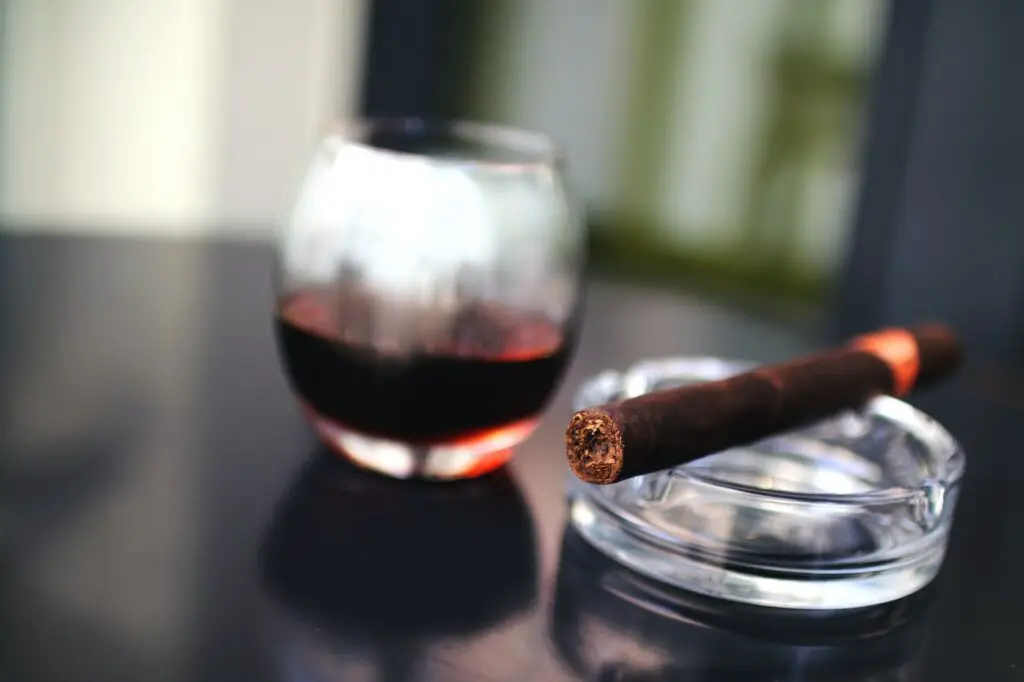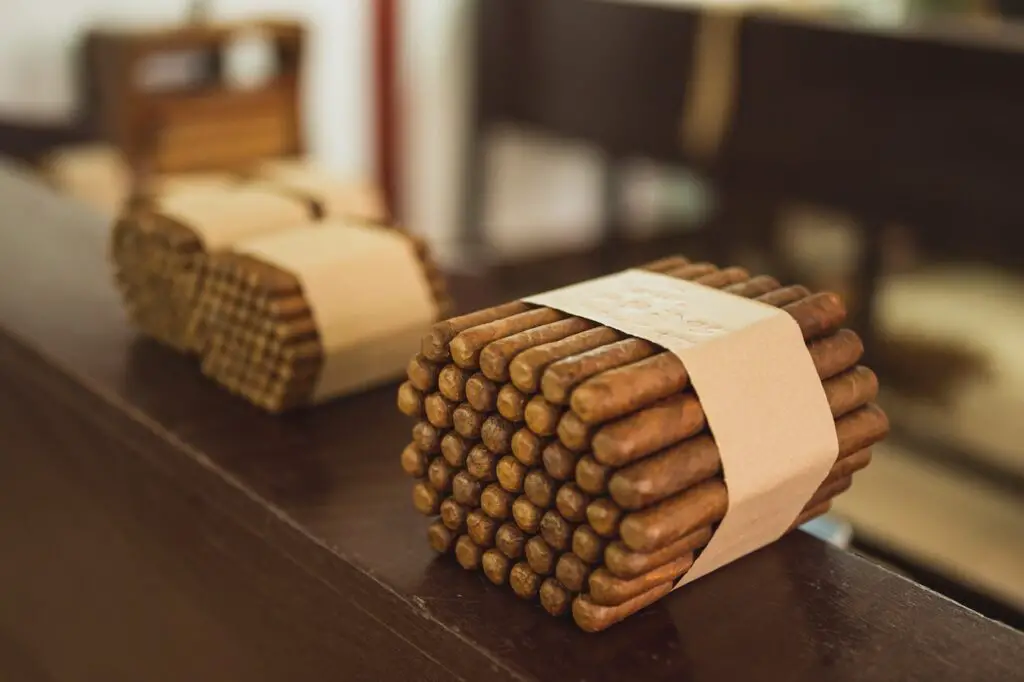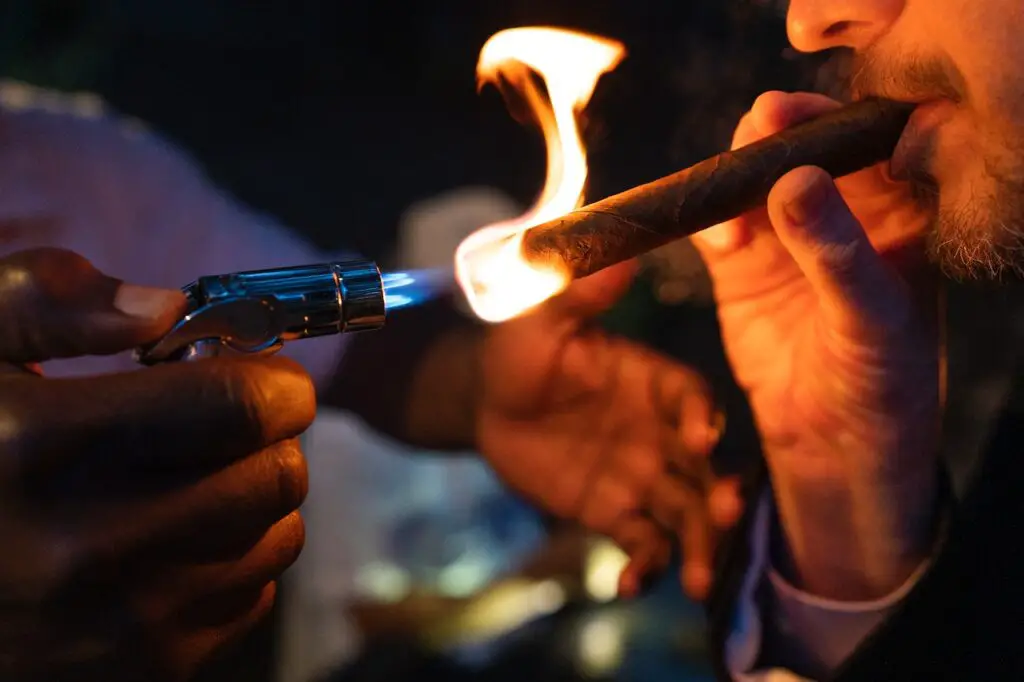The allure of cigars
The allure of cigars is undeniable. There is a certain mystique and sophistication that surrounds the world of cigars, captivating enthusiasts from all walks of life. It’s not just about smoking a cigar; it’s an experience, a ritual that engages the senses and transports you to a different realm. The rich aroma of tobacco, the smoothness of the draw, and the lingering taste on the palate create a sensory symphony that is both captivating and comforting.
Cigars have a way of bringing people together, fostering connections and conversations that transcend boundaries. Whether it’s a celebratory occasion or a moment of solitude, the allure of cigars beckons, offering a moment of respite and reflection in our fast-paced world.
Understanding the anatomy of a cigar
Understanding the anatomy of a cigar is essential for any cigar enthusiast. A cigar is a finely crafted work of art, and each component contributes to its overall character and smoking experience. Let’s delve deeper into the anatomy of a cigar.
The filler is the heart of a cigar, consisting of a blend of carefully selected tobacco leaves. These leaves determine the flavor and strength of the cigar. The binder, often made from sturdy tobacco leaves, holds the filler together and provides structural integrity. It ensures a smooth burn and even draw.
The wrapper, the outermost layer, is responsible for the cigar’s appearance and plays a significant role in its flavor profile. It is meticulously selected and skillfully applied to ensure an aesthetically pleasing and well-constructed cigar. The wrapper contributes subtle nuances to the taste, adding depth and complexity to the smoking experience.
When all these elements come together harmoniously, a cigar becomes a symphony of flavors and aromas. Understanding the anatomy of a cigar allows enthusiasts to appreciate the craftsmanship and artistry behind each blend, and it enhances the enjoyment of every puff.
Related: The 13 Best Cigars for Beginners: A Guide to Choosing Your First Cigar

Selecting the perfect cigar
Selecting the perfect cigar is an art in itself, requiring careful consideration and a discerning palate. With a vast array of options available, choosing the right cigar can seem overwhelming to beginners and seasoned enthusiasts alike. Here are some key factors to keep in mind when selecting a cigar.
Size and shape play a crucial role in the smoking experience. The length and ring gauge determine the duration and intensity of the smoke, while the shape affects the draw and mouthfeel. From the classic Churchill to the compact Robusto, each size and shape offers a unique smoking profile, catering to different preferences.
The wrapper type is another critical aspect to consider. Different wrappers, such as Connecticut, Habano, or Maduro, contribute distinct flavors and aromas to the cigar. Connecticut wrappers tend to be milder and smoother, while Maduro wrappers offer richer, bolder flavors. Exploring different wrapper types allows for a diverse range of experiences.
Additionally, consider the overall construction of the cigar. A well-constructed cigar should feel firm but not too tight. Inspect the cigar for any visible flaws or blemishes, ensuring that it is free from cracks or soft spots.
Personal preference plays a significant role in selecting the perfect cigar. Experimenting with different brands, blends, and flavor profiles allows you to discover your own palate preferences. Whether you prefer a milder smoke to savor slowly or a full-bodied powerhouse, there is a perfect cigar waiting to be discovered.

Storing and maintaining cigars
Properly storing and maintaining cigars is essential to preserve their quality and ensure an optimal smoking experience. The conditions in which cigars are stored can greatly impact their flavor, aroma, and overall enjoyment. Here are some key considerations for storing and maintaining cigars.
Investing in a humidor is highly recommended for long-term storage. A humidor is a specially designed container that helps maintain a controlled environment for cigars. It regulates temperature and humidity levels, providing an ideal climate for the cigars to age gracefully. A humidor typically contains a humidification device, such as a sponge or gel, that keeps the humidity at the desired level.
Maintaining the correct humidity is crucial. Cigars thrive in a humidity range of 65-70%. Too much moisture can lead to mold growth, while too little can cause the cigars to dry out and lose their flavors. It is essential to monitor and adjust the humidity levels regularly using a hygrometer.
Temperature control is equally important. Cigars should be stored in a cool environment, ideally around 70 degrees Fahrenheit (21 degrees Celsius). Avoid storing cigars in areas with extreme temperature fluctuations, such as near windows or heating vents.
Proper organization within the humidor is also crucial. Cigars should be arranged carefully, allowing for air circulation and preventing any contact between different brands or flavors. It’s recommended to separate cigars with individual cedar dividers to maintain their integrity.
Regularly inspect your cigars for any signs of damage or issues. Check for mold, beetles, or dryness. If you encounter any problems, address them promptly to prevent further damage.
If you don’t have a humidor, you can use temporary storage options such as a sealed plastic bag or a Tupperware container with a moist sponge or humidification pack. However, these methods are best suited for short-term storage and are not ideal for long-term aging.
Related: Cheers to Stress-Free Hearts: Unveiling the Surprising Link between Alcohol and Heart Health
Preparing to smoke a cigar
Preparing to smoke a cigar is a ritualistic process that sets the stage for an enjoyable smoking experience. Taking the time to properly prepare ensures that you can fully appreciate the flavors and aromas of the cigar. Here are some essential steps to follow when preparing to smoke a cigar.
First, remove the cigar from the humidor in advance and allow it to acclimate to the ambient conditions. This process, known as “resting,” ensures that the cigar reaches an optimal moisture level, enhancing the overall smoking experience.
Next, carefully examine the cigar for any visible flaws or construction issues. Check for any cracks, soft spots, or unevenness in the wrapper. Ensuring that the cigar is in good condition will contribute to a smooth and even burn.
Before lighting the cigar, it’s important to cut the cap. Use a sharp cigar cutter to make a clean cut just above the shoulder of the cigar. This allows for an optimal draw and prevents the cigar from unraveling during smoking.
Once the cigar is cut, take a moment to appreciate the pre-light aroma. Gently sniff the foot of the cigar, inhaling the subtle scents of the tobacco. This preview of the flavors to come builds anticipation and heightens the sensory experience.
Finally, hold the cigar comfortably between your fingers, ready to be ignited. Pause for a moment to reflect on the journey you’re about to embark on. Allow yourself to relax and savor the upcoming moments of indulgence.
Related: Elevate Your Home Bar: Cocktail Recipes Every Gentleman Should Know
The art of cutting and lighting a cigar
The art of cutting and lighting a cigar is a crucial aspect of the cigar-smoking experience. A proper cut and an even light are essential to ensure a smooth draw and an even burn throughout the cigar. Here are some key techniques to master the art of cutting and lighting a cigar.
When it comes to cutting a cigar, precision is paramount. Use a sharp cigar cutter to make a clean cut just above the shoulder of the cigar, ensuring not to remove too much of the cap. A straight cut or a V-cut are common choices, each providing a different draw experience. Experiment with different cutting methods to find the one that suits your preference.
Once the cigar is cut, it’s time to light it. Use a wooden match or a butane lighter to ignite the foot of the cigar. Hold the flame slightly below the foot without touching it, allowing the heat to gradually toast the tobacco. Rotate the cigar while gently puffing on it to ensure an even light.

Smoking techniques and etiquette
Smoking a cigar is not just about the act of puffing on it; it’s a ritual that involves specific techniques and etiquette. Mastering these techniques and adhering to proper cigar-smoking etiquette enhances the experience and demonstrates respect for the art. Here are some essential smoking techniques and etiquette guidelines to follow:
Puffing and drawing
Take slow, gentle puffs on the cigar, allowing the flavors to develop on your palate. Avoid inhaling the smoke into your lungs, as cigars are meant to be enjoyed for their aroma and taste.
Ash management
Allow the ash to form naturally and hold it as long as possible before gently tapping it into an ashtray. A longer ash can help insulate the cigar, promoting an even burn.
Rotation
Rotate the cigar between your fingers while smoking to ensure an even burn and prevent one side from burning faster than the other. This technique helps maintain the cigar’s balance and flavor profile.
Relighting
If the cigar goes out, gently blow on the foot to remove any residual ash, then relight it. Take a moment to purge the cigar by puffing gently before resuming your smoking.
Conversation and pacing
Engage in conversation and savor the moments between puffs. Allow the cigar to rest periodically to prevent overheating and maintain its flavors.
Ashtray usage
Use an ashtray to collect the ash and discarded cigar remnants. Dispose of the cigar respectfully, avoiding littering or leaving ash and debris in inappropriate places.
Consideration for others
Be mindful of those around you when smoking. Respect non-smoking areas and the preferences of others who may not appreciate the aroma of a lit cigar.
Savoring the flavors and aromas
One of the most captivating aspects of cigars is the wide range of flavors and aromas they offer. From earthy and woody notes to hints of spice and sweetness, each cigar has its unique profile. Taking the time to savor and identify these nuances enhances the overall smoking experience.
Pairing cigars with beverages
Pairing cigars with suitable beverages can elevate the flavors of both. Certain beverages, such as whisky, rum, and coffee, complement the flavors of cigars exceptionally well. Understanding the characteristics of different beverages and their compatibility with various cigar profiles allows for a harmonious pairing.

Exploring different types of cigars
Exploring different types of cigars is an exciting journey that allows you to discover a wide range of flavors, strengths, and characteristics. Cigars come in various styles, each offering a unique smoking experience. Here are some of the different types of cigars to explore:
Mild-bodied cigars
These cigars are known for their smoothness and subtle flavors. They are an excellent choice for beginners or those who prefer a lighter smoke. Mild-bodied cigars often feature Connecticut wrappers and provide a delicate and creamy experience.
Medium-bodied cigars
These cigars offer a balance between strength and flavor. They provide a more pronounced taste profile while still maintaining a smooth and enjoyable smoke. Medium-bodied cigars often feature a variety of wrappers, including Habano and Sumatra, which contribute to their complexity.
Full-bodied cigars
These cigars are bold and robust, with intense flavors and a higher nicotine content. They are preferred by experienced smokers who enjoy a more powerful and impactful smoking experience. Full-bodied cigars often feature Maduro or Oscuro wrappers, which lend a richness and depth to the flavor profile.
Flavored cigars
These cigars are infused with various flavors, such as vanilla, coffee, or fruit. They offer a unique and enhanced smoking experience, appealing to those who enjoy a touch of sweetness or aromatic notes.
Limited edition and boutique cigars
These cigars are often produced in small quantities and showcase unique blends and rare tobacco. Exploring limited edition and boutique cigars allows you to discover hidden gems and experience truly exceptional smoking moments.
Cigar culture and appreciation
Cigars have a rich cultural heritage and a devoted following. From cigar lounges and clubs to social events and festivals, there are numerous opportunities to connect with fellow enthusiasts and share the joy of cigars. Appreciating the craftsmanship and artistry that goes into creating each cigar adds depth to the experience.
Health considerations and moderation
While the enjoyment of cigars is a pleasurable pursuit, it’s important to be mindful of health considerations. Cigar smoking should be approached with moderation, and individuals should be aware of the potential risks associated with tobacco use. Understanding and practicing responsible cigar smoking ensures a balanced approach to this hobby.
The future of cigars
As societal attitudes and regulations surrounding tobacco continue to evolve, the future of cigars is subject to change. However, the art of selecting, smoking, and appreciating cigars will persist, as it embodies tradition, craftsmanship, and camaraderie. Cigar enthusiasts remain dedicated to preserving and celebrating this timeless pastime.
Conclusion
The art of cigars encompasses a journey of exploration and appreciation. From the moment you select a cigar to the final puff, it’s a sensory experience that engages all the senses. By understanding the intricacies of cigars, practicing proper techniques, and embracing the culture surrounding them, you can embark on a fulfilling and rewarding cigar-smoking journey.
FAQs
Are cigars addictive like cigarettes?
Cigars contain nicotine, which can be addictive. However, the level of nicotine in cigars is generally lower compared to cigarettes. It’s essential to smoke cigars in moderation and be aware of the potential risks.
How should I store my cigars without a humidor?
If you don’t have a humidor, you can use alternative methods such as ziplock bags with a moist sponge or airtight containers with a humidification pack to store your cigars temporarily.
Can I relight a partially smoked cigar?
Yes, it’s possible to relight a partially smoked cigar. However, keep in mind that the flavor and overall experience may be affected.
What is the ideal environment for cigar storage?
The ideal environment for cigar storage is a temperature of around 70 degrees Fahrenheit (21 degrees Celsius) and a humidity level of 65-70%.
Are flavored cigars a good choice for beginners?
Flavored cigars can be an enjoyable choice for beginners due to their milder profiles and added flavors. However, exploring different non-flavored cigars is recommended to develop a well-rounded palate.

